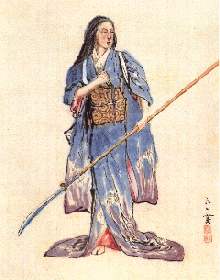Today, when we think of tie-dye, we automatically imagine the sixties and seventies with their peace movements, flower power and Woodstock. However, the art of dying fabrics and specifically tie-dying goes far back in time. Men has always had the urge to adorn him or herself. Nature is full of colors and very early on it was understood that those colors nature offered could be used to beautify the clothes one wore.
 China and Japan had fully developed the art of tie-dye as early as the sixth century AD, about one and a half millennia ago. Hemp and silk which are very receptive to dying had become available and made this outstanding art possible. Instead of dying the finished garment some tribes in Central America, South East Asia and Western China dyed the threads before weaving. Technically this was not tie-dye but the beauty of the designs that appeared was striking as were the patterns done with tie-dying.
China and Japan had fully developed the art of tie-dye as early as the sixth century AD, about one and a half millennia ago. Hemp and silk which are very receptive to dying had become available and made this outstanding art possible. Instead of dying the finished garment some tribes in Central America, South East Asia and Western China dyed the threads before weaving. Technically this was not tie-dye but the beauty of the designs that appeared was striking as were the patterns done with tie-dying.
Today we are used to synthetic dyes that are easy to use because they are safe, long lasting and quick setting, but in the early days dyes had to be extracted from nature. Sources of these dyes were roots, berries and the flowers and leaves of a variety of plants like blackberries, safflower, marigold, sage, indigo and many others. Some of these natural dyes are still used today. They are of very great interest to the artist who work in close proximity to nature and who promotes organic fabric and clothing. As a fiber used for the dyed clothing, natural materials offer themselves very prevalently as they take the dye much better than many synthetic fibers.
During the Momoyama period, which lasted for about 30 years at the end of the 16th century, a new fiber-art form developed which combined tie-dye with ornamental drawing. This art form spanned the whole gamut from a piece consisting of mostly tie-dye on one end to large un-dyed areas for drawing flower, tree and landscape designs on the other end of the spectrum.
In Japan this form was used to create kimonos awarded to officers by the warlords in recognition of special bravery in battle with neighboring adversaries. These kimonos were a very valuable family possession and have often been passed down from generation to generation. Today many of those art pieces can be found in museums. The natural dyes might have faded but the depicted designs are still magnificent.
It is interesting to notice that a few centuries later tie-dye became the symbol of non-conflict, understanding and peace. This generation of baby boomers is now in a position where it has time to reflect after their most productive time in life, and we notice a growing interest and a revival of tie-dye. Often today’s tie-dye pieces are of much higher art value than the sixties Woodstock t-shirts and in particular when combined with the traditional Asian Mudmee tie-dye, garments become wearable art.
